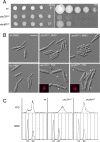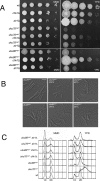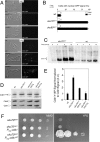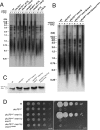Fungal Ku prevents permanent cell cycle arrest by suppressing DNA damage signaling at telomeres
- PMID: 25653166
- PMCID: PMC4344518
- DOI: 10.1093/nar/gkv082
Fungal Ku prevents permanent cell cycle arrest by suppressing DNA damage signaling at telomeres
Abstract
The Ku heterodimer serves in the initial step in repairing DNA double-strand breaks by the non-homologous end-joining pathway. Besides this key function, Ku also plays a role in other cellular processes including telomere maintenance. Inactivation of Ku can lead to DNA repair defects and telomere aberrations. In model organisms where Ku has been studied, inactivation can lead to DNA repair defects and telomere aberrations. In general Ku deficient mutants are viable, but a notable exception to this is human where Ku has been found to be essential. Here we report that similar to the situation in human Ku is required for cell proliferation in the fungus Ustilago maydis. Using conditional strains for Ku expression, we found that cells arrest permanently in G2 phase when Ku expression is turned off. Arrest results from cell cycle checkpoint activation due to persistent signaling via the DNA damage response (DDR). Our results point to the telomeres as the most likely source of the DNA damage signal. Inactivation of the DDR makes the Ku complex dispensable for proliferation in this organism. Our findings suggest that in U. maydis, unprotected telomeres arising from Ku depletion are the source of the signal that activates the DDR leading to cell cycle arrest.
© The Author(s) 2015. Published by Oxford University Press on behalf of Nucleic Acids Research.
Figures







Similar articles
-
Mre11 and Blm-Dependent Formation of ALT-Like Telomeres in Ku-Deficient Ustilago maydis.PLoS Genet. 2015 Oct 22;11(10):e1005570. doi: 10.1371/journal.pgen.1005570. eCollection 2015 Oct. PLoS Genet. 2015. PMID: 26492073 Free PMC article.
-
Ku: a multifunctional protein involved in telomere maintenance.DNA Repair (Amst). 2005 Nov 21;4(11):1215-26. doi: 10.1016/j.dnarep.2005.04.021. Epub 2005 Jun 24. DNA Repair (Amst). 2005. PMID: 15979949 Review.
-
Telomere-related functions of yeast KU in the repair of bleomycin-induced DNA damage.Biochem Biophys Res Commun. 2007 Jun 8;357(3):800-3. doi: 10.1016/j.bbrc.2007.04.011. Epub 2007 Apr 10. Biochem Biophys Res Commun. 2007. PMID: 17442269
-
The Ku heterodimer: function in DNA repair and beyond.Mutat Res Rev Mutat Res. 2015 Jan-Mar;763:15-29. doi: 10.1016/j.mrrev.2014.06.002. Epub 2014 Jul 4. Mutat Res Rev Mutat Res. 2015. PMID: 25795113 Review.
-
Components of the Ku-dependent non-homologous end-joining pathway are involved in telomeric length maintenance and telomeric silencing.EMBO J. 1998 Mar 16;17(6):1819-28. doi: 10.1093/emboj/17.6.1819. EMBO J. 1998. PMID: 9501103 Free PMC article.
Cited by
-
Structurally distinct telomere-binding proteins in Ustilago maydis execute non-overlapping functions in telomere replication, recombination, and protection.Commun Biol. 2020 Dec 16;3(1):777. doi: 10.1038/s42003-020-01505-z. Commun Biol. 2020. PMID: 33328546 Free PMC article.
-
Analysis of the indispensable RAD51 cofactor BRCA2 in Naganishia liquefaciens, a Basidiomycota yeast.Life Sci Alliance. 2023 Nov 28;7(2):e202302342. doi: 10.26508/lsa.202302342. Print 2024 Feb. Life Sci Alliance. 2023. PMID: 38016757 Free PMC article.
-
Ustilago maydis Trf2 ensures genome stability by antagonizing Blm-mediated telomere recombination: Fine-tuning DNA repair factor activity at telomeres through opposing regulations.PLoS Genet. 2024 Dec 9;20(12):e1011515. doi: 10.1371/journal.pgen.1011515. eCollection 2024 Dec. PLoS Genet. 2024. PMID: 39652599 Free PMC article.
-
The contribution of DNA repair pathways to genome editing and evolution in filamentous pathogens.FEMS Microbiol Rev. 2022 Nov 2;46(6):fuac035. doi: 10.1093/femsre/fuac035. FEMS Microbiol Rev. 2022. PMID: 35810003 Free PMC article. Review.
-
Bioavailability of Nutritional Resources From Cells Killed by Oxidation Supports Expansion of Survivors in Ustilago maydis Populations.Front Microbiol. 2018 May 17;9:990. doi: 10.3389/fmicb.2018.00990. eCollection 2018. Front Microbiol. 2018. PMID: 29867888 Free PMC article.
References
-
- Deriano L., Roth D.B. Modernizing the nonhomologous end-joining repertoire: alternative and classical NHEJ share the stage. Annu. Rev. Genet. 2013;47:433–455. - PubMed
-
- Panier S., Boulton S.J. Double-strand break repair: 53BP1 comes into focus. Nat. Rev. Mol. Cell Biol. 2014;15:7–18. - PubMed
-
- Downs J.A., Jackson S.P. A means to a DNA end: the many roles of Ku. Nat. Rev. Mol. Cell Biol. 2004;5:367–378. - PubMed

